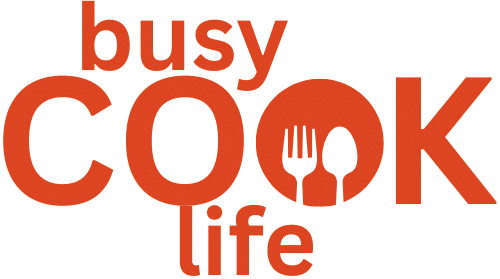After bedtime stories and a sink full of sippy cups, I finally get a minute. I breathe in the kettle steam and think about dinner that calms me. I lean into complex carbs for weight loss because they curb late-night cravings and keep my energy steady. They digest slowly, so I stay full and sane until lights out.
I say the phrase out loud—yes, really—because naming the plan helps when takeout menus whisper. I pick oats, beans, quinoa, and that cooled potato with resistant starch. These choices bring fiber, steady fuel, and kinder blood sugar swings.
My style is simple. I cook once and eat twice. Tonight’s bowl becomes tomorrow’s easy lunch, and that tiny win matters when a toddler tugs at my apron.
Key Takeaways
- Choose slow-digesting grains and legumes to feel fuller, longer.
- Fiber-rich swaps help steady blood sugar and reduce cravings.
- Prep once; enjoy leftovers to save time and money.
- Small kitchen wins add up and make it easier to lose weight gently.
- Simple pantry staples—oats, beans, sweet potato—make meals cozy and doable.
Tonight’s cozy plan: how I lean on complex carbs after a long day
When the house finally quiets, I reach for food that soothes and sticks with me. I want dinner in under 15 minutes. I want something that keeps blood sugar steady and lets me sit down without pacing back to the pantry.
So here’s how I do it after a marathon of laundry and Legos: I pick whole grains or beans, add a small pinch of protein, and keep one-pan cleanup in mind.
The toddler test: fast, filling, and no blood sugar roller coaster
This is my checklist:
- Skip simple carbs when I’m wiped—those quick spikes in blood sugar levels lead to a crash.
- Build a bowl that holds: a can of beans, frozen veggies, and something grainy from the shelf.
- Protein is simple—an egg, chickpeas, or leftover chicken finishes the plate.
- If it mixes in one bowl and a toddler can nibble safely, it’s a keeper.
- This one’s saved my week more than once: microwave oats for me, buttered peas for the kid, fruit for both. See easy mug recipes here.
Then I sit, breathe, and actually taste my dinner. Small choices like these help me stay steady, warm, and a bit more human at bedtime.
complex carbs for weight loss: what they are and why they work
I keep a few slow-burning staples in the pantry so dinner feels steady, not frantic. I want food that fills me and keeps energy even. Below I explain what these choices do and why they help.
Simple vs. complex: the digest-slow win for steady energy
Complex carbohydrates are long chains of sugar units. They take longer to break down, so your body gets fuel bit by bit. Meals feel filling and steady.
By contrast, simple carbs absorb fast. They can raise blood sugar quickly and prompt more cravings. That quick spike and dip is what tires me out on busy nights.
Fiber and fullness: why these carbs take longer and help you lose weight
Fiber is the indigestible part that adds bulk. It slows digestion and helps you feel satisfied sooner. It also keeps digestion moving and supports gut health.
- Choose whole grains, beans, and starchy veggies like sweet potato.
- Pair them with a little protein to slow things more.
- Regular meals with fiber can support gentle weight loss without drama.
In short: favor slow-burning options and fiber. They tame sugar swings, cut late-night snacking, and make real life—dinner, bedtime, repeat—feel doable.
Whole-grain pantry heroes I reach for on autopilot
My go-to meal plan starts with a cup of something whole and honest. I keep a few reliable staples that turn tired nights into warm bowls. They save time and taste like effort.
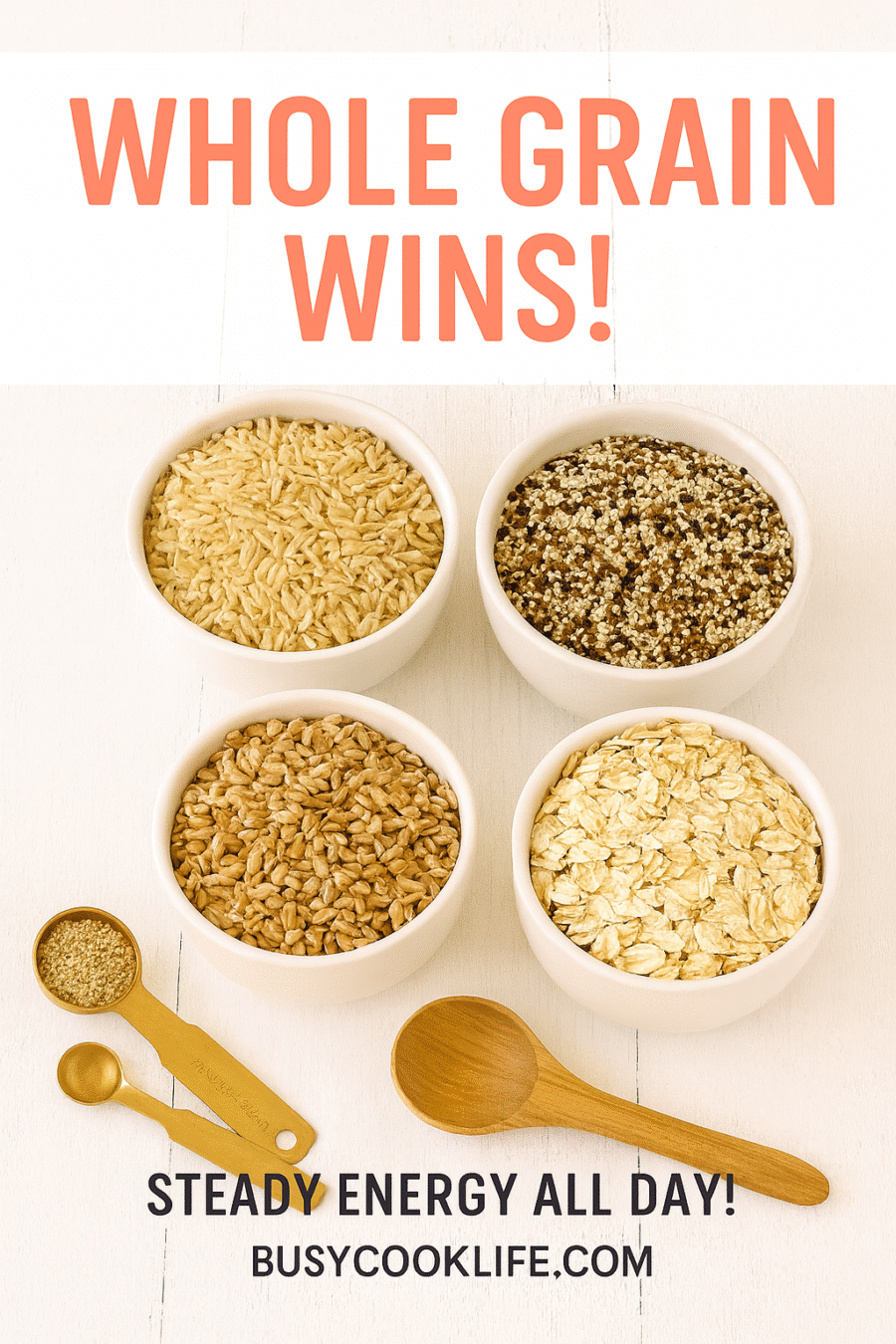
Brown rice, farro, and barley: chewy, nutty, satisfying
- Brown rice is my mellow base—it keeps the germ and bran, so it adds more fiber and protein than plain white rice.
- Farro brings a chewy bite. It makes salads feel like dinner, not a side.
- Barley is cozy soup fuel. About six grams of fiber per cooked cup helps me stay full.
Quinoa and millet: gluten-free, protein-forward, weeknight easy
- Quinoa cooks fast, adds protein, and gives extra fiber to a simple bowl.
- Millet is gentle on the belly and pairs well with roasted veggies and herbs.
- I batch-cook grains, toss them with lemon and olive oil, then add a handful of greens for instant nutrition.
- If I want crunch, I toast the grain in a dry pan first—flavor doubles in minutes.
Pantry heroes beat hanger. These grains deliver steady carbs and small wins on busy nights.
Oats for breakfast, lunch, and “I forgot dinner” nights
Oats rescue my day more often than takeout does. I keep old-fashioned oats on the counter. They take little work and give big payoff.
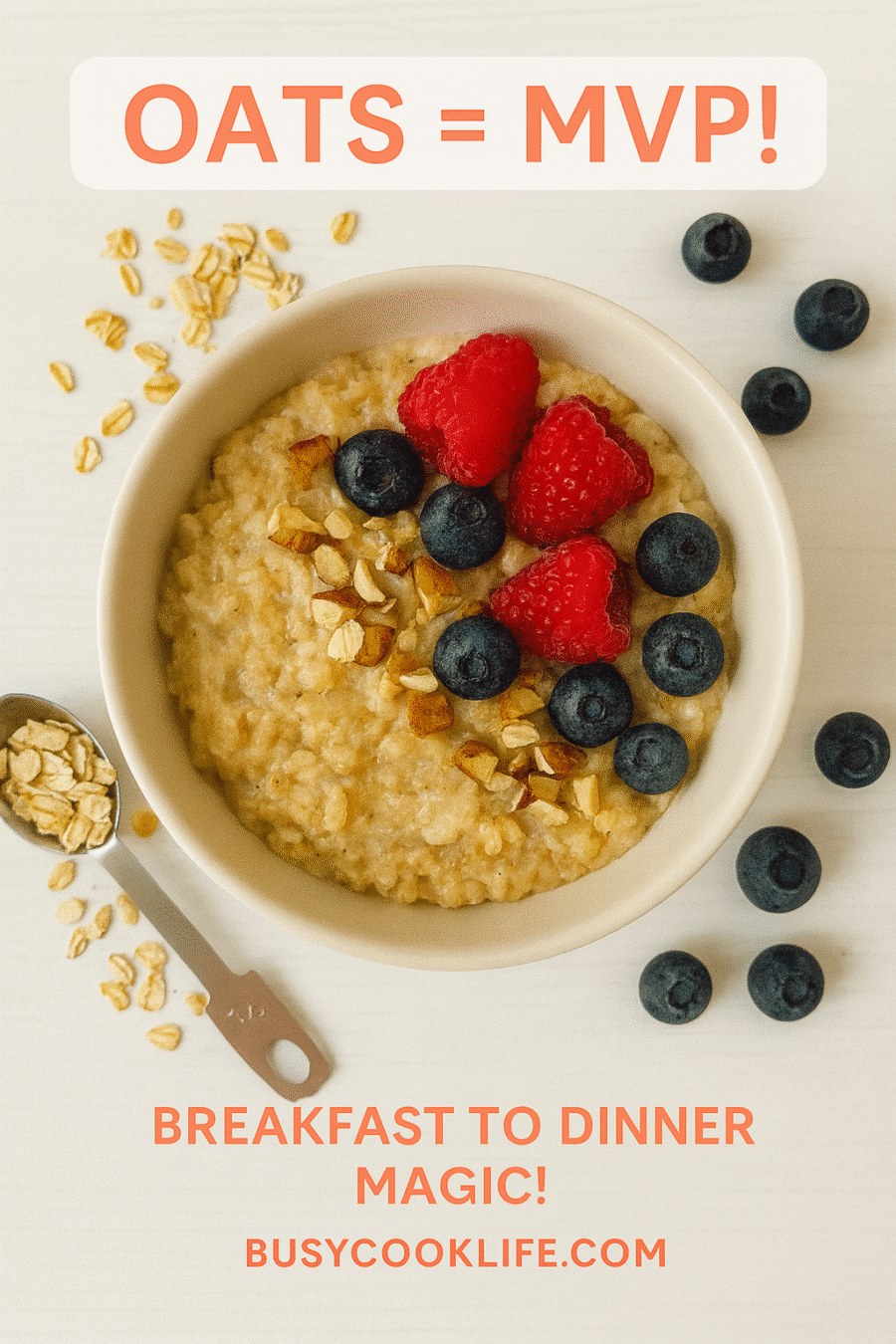
Old-fashioned over instant: the fiber and grams protein bump
Half a cup of old-fashioned oats has about 4 g fiber and roughly 5 g protein. That mix slows the release of sugars into the blood and keeps energy steady.
- I stir in peanut butter and berries for extra grams protein and taste.
- Lunch can be savory: oats, an egg, spinach, and hot sauce—five minutes, done.
- On “I forgot dinner” nights I microwave oats with frozen peas, parmesan, and olive oil. It’s weirdly cozy.
- For the kiddo I mash banana in—sweet, simple, and steady on blood sugar.
Soluble fiber in oats helps lower LDL and supports heart health. They also help me manage weight because a full bowl fills my belly and cuts snacking.
I call oats one of my kitchen MVPs. These slow-burning carbs are cheap, fast, and endlessly flexible. Oats are true complex carbs that hustle in real life.
Beans and lentils that keep me full for hours
I keep a can of beans in my pantry like an old friend—always ready to help. They save time and soothe hunger. One cup of cooked beans or lentils gives roughly 12–16 g fiber and 15–18 g protein. That combo fills me longer than snacks do.
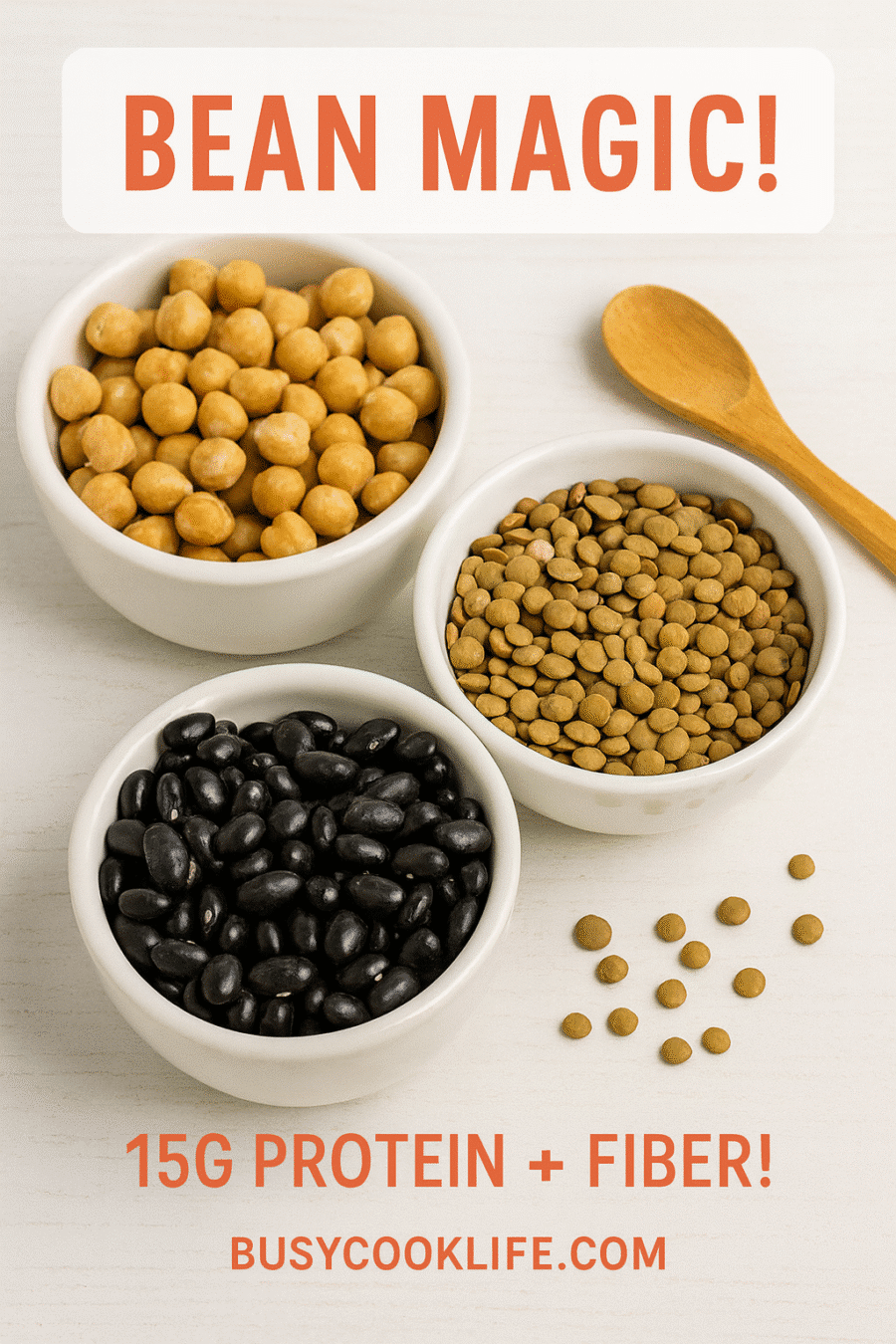
Black beans, chickpeas, and lentils: the protein-fiber duo
I stock black beans and chickpeas—pop the lid, rinse, done. Lentils cook fast and feel hearty with broth and veggies. These legumes hit the protein and fiber that keep my appetite steady.
Salads, soups, and skillet toss-ins that actually satisfy
I toss chickpeas into salads with cucumber, tomato, and feta and cravings vanish. Black beans make quesadillas hearty without extra cheese. Lentils turn broth and carrots into dinner in 20 minutes.
- Quick bean dip: blitz beans, lemon, garlic, olive oil, salt.
- Skillet bowls: rice, black beans, salsa—one pan, little fuss.
- Family-friendly meals that stay affordable and filling.
| Legume | Approx. Protein (1 cup) | Approx. Fiber (1 cup) |
|---|---|---|
| Black beans | 15–17 g | 12–15 g |
| Chickpeas | 14–16 g | 12–13 g |
| Lentils | 16–18 g | 15–16 g |
These foods help my body and may improve LDL cholesterol. Regular bowls with beans make my weight loss goals feel doable, not strict. If I’m tired, I lean on quick mug recipes like the ones at mug dinners.
Sweet potatoes and other slow-and-steady starches
On chilly nights I grab a sweet potato like it’s a hug in foil. It heats fast, tastes cozy, and steadies my appetite. These tubers release sugar slowly thanks to fiber and pack vitamins A, C, and B6. I microwave mine when time is tight—stab, wrap, zap, done.
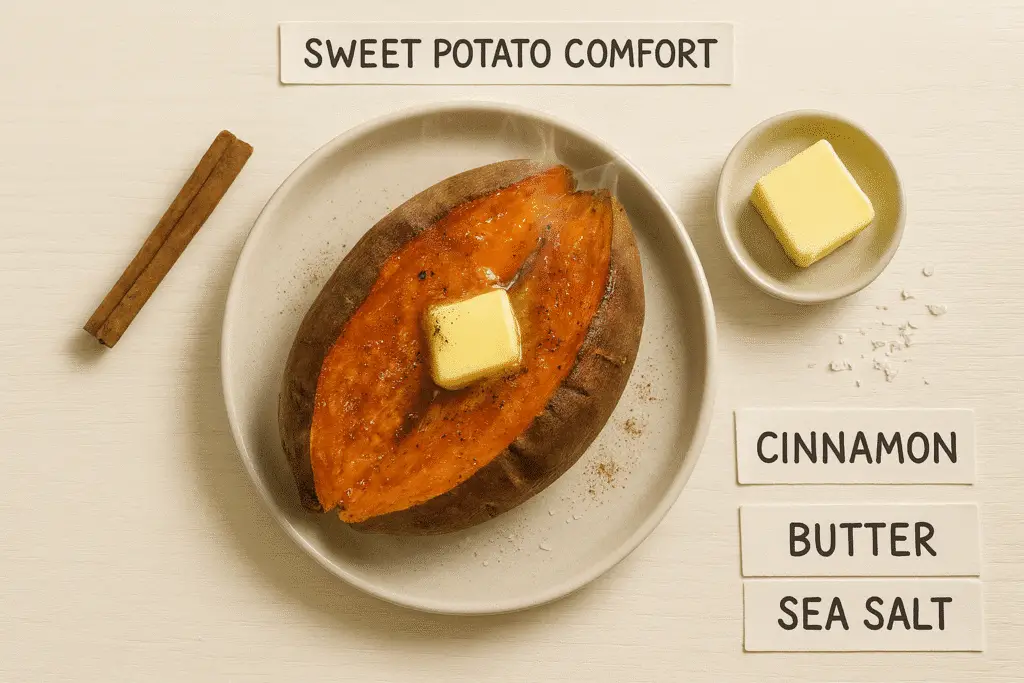
Sweet potatoes, potatoes, and butternut squash: cozy comfort without the crash
White potatoes have a trick too. Cook them, cool them, and resistant starch forms. That slows digestion and eases blood sugar spikes. I make a batch, then toss pieces into quick salads the next day.
Butternut squash roasts into caramel bites with almost zero fuss. It’s low-cal and gives vitamin E, so plates feel indulgent yet light. These vegetables are warm, simple, and steady.
- I microwave sweet potatoes when I need instant cozy—stab, wrap, zap, done.
- Cooled potatoes add resistant starch; I prep a few on Sunday.
- A pat of butter, salt, and pepper sometimes equals dinner.
Complex carbs like these lift daily health in small ways. Colorful plates bring protective nutrients that may lower risk of chronic disease. Honestly, that little win matters most.
Whole-wheat bread and pasta without the afternoon slump
On busy nights I grab a slice of hearty bread that actually keeps me going. A few label checks save me from a sugar dip later.
What the label should say
I look for “100% whole grain” as the first ingredient. That tells me the grains are real, not refined. I aim for at least 2–3 g fiber content per slice and check the grams protein if listed.
Pasta night tricks
Whole wheat pasta beats white pasta at staying power. I plate less and feel fuller when veggies, a drizzle of olive oil, and lean protein share the bowl.
- I skip white bread most days—doesn’t hold me till dinner.
- Add beans or chicken to boost grams protein and bulk up the plate.
- Olive oil, garlic, and herbs add flavor without extra fuss.
- Portion control matters—more veg means smaller pasta portions work fine.
| Item | Why I pick it | Quick tip |
|---|---|---|
| 100% whole grain bread | More fiber, steady energy | Check ingredient list and fiber per slice |
| Whole-wheat pasta | Keeps you full longer than white pasta | Mix with veggies and a lean protein |
| Grain bowls | Balanced nutrition and volume | Batch-cook grains; reuse all week |
Bonus: when I need a quick dinner hack, I turn to simple mug recipes like the veggie omelet mug — an easy swap that saves time and steadies blood sugar levels. See the mug recipe here.
Snack breaks that love your blood sugar
When hunger pings between meetings, I reach for something that behaves. Snacks should be small, portable, and actually keep my energy steady.
Air-popped popcorn and high-fiber crackers: crunchy, quick, better
I pop popcorn in a brown paper bag—1/4 cup kernels, fold the top, microwave about 2 minutes. That yields roughly 3 cups with no added oil. Big, crunchy bowl, zero fuss.
I call popcorn one of the best carbs for movie nights and mid-afternoon hunger. It fills me fast without a sugar crash.
I also keep high-fiber crackers on hand. I check the ingredient list—short, whole-grain items only. A swipe of peanut butter or a slice of cheddar adds protein and staying power.
- Add cinnamon to popcorn if you want dessert vibes without a sugar dump.
- Pair fruit with nuts and a few crackers for quick, balanced fuel.
- Pack foods you actually like so you don’t boomerang to candy.
Simple, crunchy, salty—snack needs met without a nap after. Real food, easy method, happy me.
Vegetables that quietly boost fiber and balance
A quick scoop of veggies can calm a rumble and brighten a plate. I mean tiny add-ins that change the whole meal. They help meals feel bigger without much work.
Broccoli and green peas: small sides, big wins
I throw broccoli into soups, skillets, and grain bowls—tiny trees, big impact. Broccoli gives fiber and vitamin C, plus sulforaphane that feels protective.
Green peas thaw fast and add fiber plus vitamins A, C, K, and folate. They bring sweet pops my kid will actually eat. I keep a bag of frozen peas in the door for emergencies.
Carrots for crunch and color on busy days
Carrots slice quick, crunch loud, and bring beta carotene and potassium. They add color and chew that makes plates feel complete.
- These veggies add carbs mostly as fiber, so they fill without fuss.
- I roast a sheet pan once, then mix into lunches all week.
- A lemon squeeze and a pinch of salt make simple sides taste special.
- Even a half cup tossed into dinner helps me stay satisfied.
- Consistency beats perfection—one small scoop at a time.
Health gets a quiet boost from vitamins and plant compounds. Little shifts like this may help lower risk of chronic disease. Read more about smart veg swaps at Vegetables that rule weight loss.
Fruit friends for steady energy
Fruit lives in my bag like tiny emergency helpers—sweet, honest, and ready to calm a rumble. I reach for them when I need quick fuel that behaves. They travel well, share with the kid, and cut cravings without drama.
Bananas: potassium power and grab‑and‑go fuel
Bananas are my pocket-sized electrolyte boost. A medium banana has about 105 calories and roughly 3.1 g fiber. That potassium helps with electrolyte balance and supports healthy blood pressure.
I peel one on the run, or slice it into oats. It gives steady energy and saves snack-time stress.
Blueberries and apples: sweet balance and bite
Blueberries taste like candy but bring polyphenols that may help prevent fat accumulation. I toss them into yogurt, oats, or a toddler bowl—instant upgrade.
Apples give a satisfying crunch and skin full of fiber and flavonoids. They slow sugar spikes so snacks stay steady.
- Bananas live in my bag—instant energy and kind to blood pressure.
- Blueberries add polyphenols and extra fiber-like goodness.
- Apples crunch loud and keep me full till dinner.
- Pair fruit with a handful of nuts for protein and balance on the go.
- If I want to lose weight without overthinking, fruit keeps snacks simple and smart.
Health stacks up when fruit shows up daily—no complicated plan needed. For dessert, I microwave apple slices with cinnamon. Warm, sweet, and cozy—everybody wins.
So here’s how I do it: simple microwave-friendly recipe secrets
When the microwave dings, dinner is suddenly doable. I keep a few cooked grains and cans of beans so hot bowls are three minutes away.
Five-minute quinoa bowl with beans, broccoli, and a squeeze of lemon
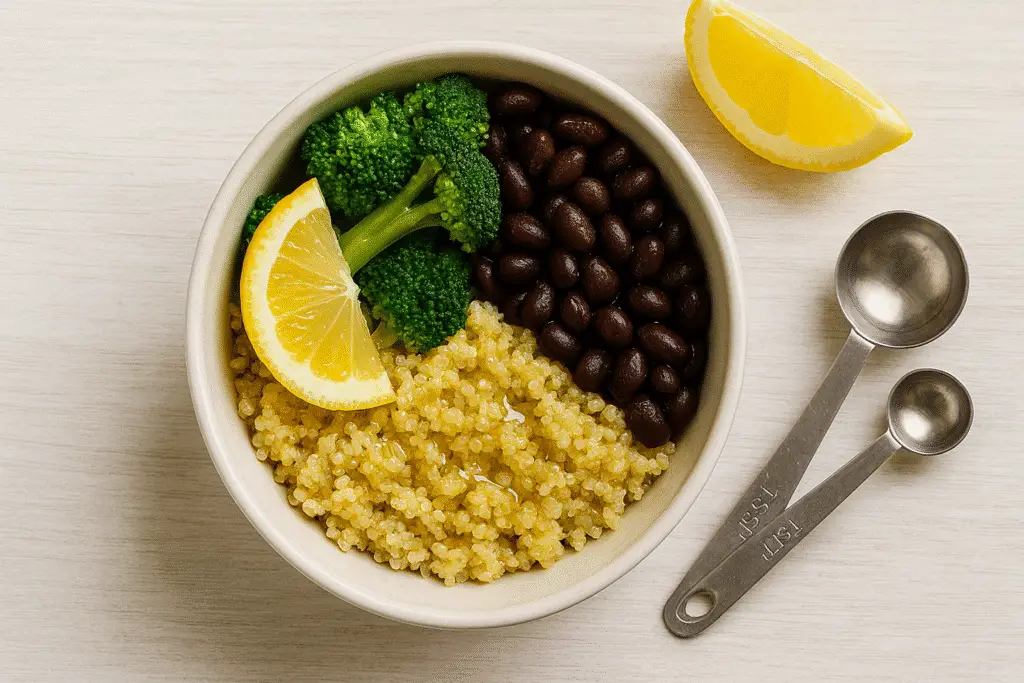
Step 1: Spoon 1 cup cooked quinoa into a microwave-safe bowl. Heat 60–90 seconds.
Step 2: Stir in 1/2 cup rinsed beans and a handful of frozen broccoli. Microwave 45–60 seconds.
Step 3: Drizzle olive oil, squeeze lemon, pinch salt, and add garlic powder or smoked paprika. Eat hot. This delivers quick protein and fiber with almost no fuss.
Mug magic: oatmeal, eggy grain bakes, and savory bean mugs
I use BusyCookLife.com’s mug recipes when I need zero dishes. Oatmeal mugs, eggy grain bakes, and savory bean mugs save my week.
Example: stir oats, an egg, a splash of milk, and spinach in a mug. Microwave 90 seconds. Top with hot sauce. Instant meal.
See more mug ideas at BusyCookLife.com’s mug recipes.
Leftover rice to brown rice bowls: veggies, herbs, and a protein pinch
Leftover rice? Reheat 60–90 seconds with a splash of water. Toss in frozen peas or chopped spinach—those add fiber fast.
Add a protein pinch: an egg, canned tuna, or a scoop of beans. Season with vinegar, olive oil, and smoked paprika. Swap quinoa with farro or barley if needed.
| Quick Bowl | Microwave Time | Why I pick it |
|---|---|---|
| Quinoa + beans + broccoli | 2–3 min | High protein, ~5 g fiber per cup cooked quinoa |
| Oatmeal mug (savory) | 1.5 min | Fast, filling, easy to customize |
| Leftover rice bowl | 1–2 min | Uses whole grains like brown rice; low prep, big payoff |
Quick seasoning tips: garlic powder, smoked paprika, and a splash of vinegar wake any grain. Toss peas or spinach in to boost fiber. These steps keep carbs steady by pairing whole grains with beans and veggies every time.
Real life wins: minimal dishes, max taste, and meals that fit any diet rhythm—weeknights, naps, or frantic afternoons. Content that works? That’s my kitchen goal.
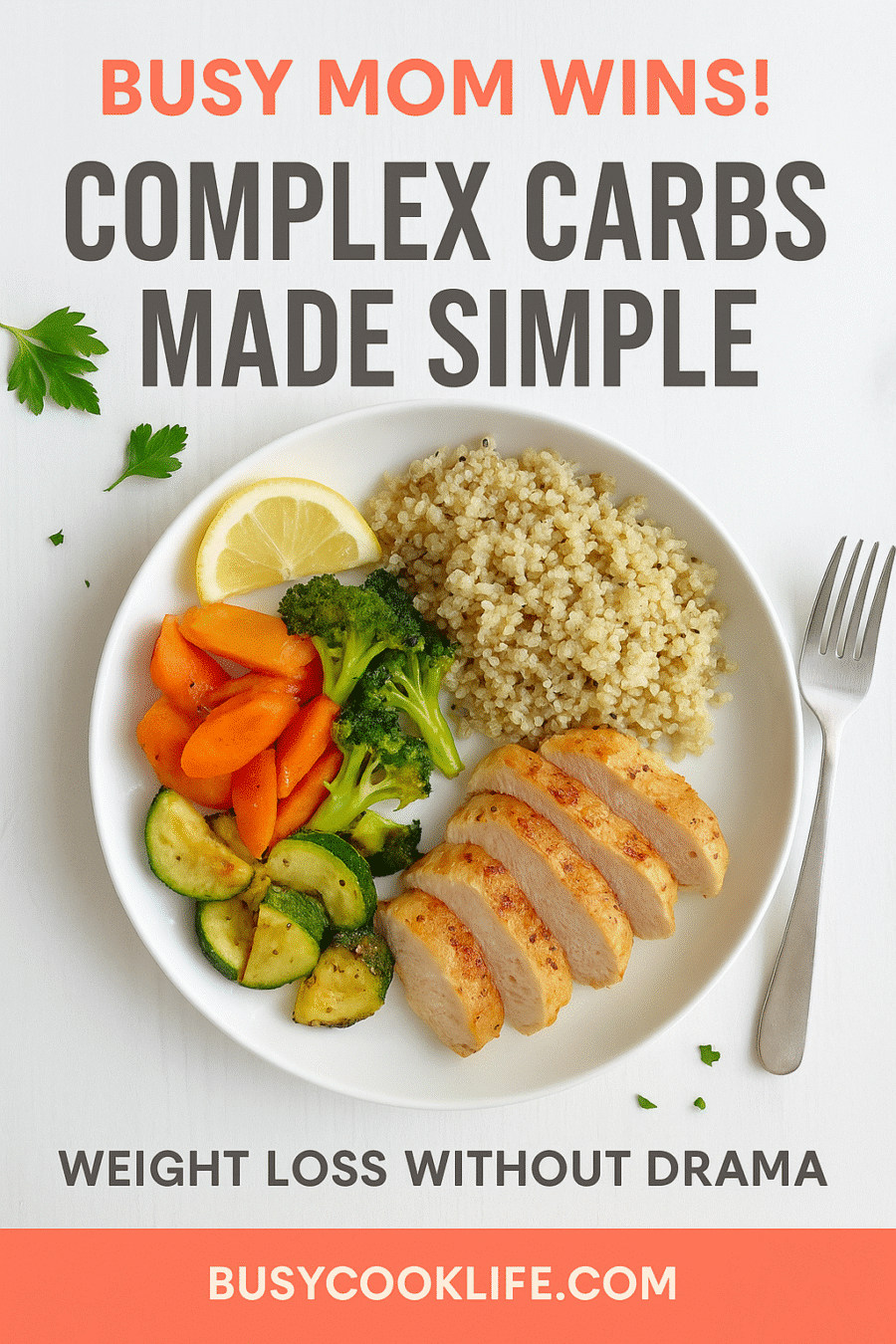
Conclusion
A single swap at dinner can change how your days stack up. I build meals around whole grains, beans, and colorful veggies. These choices bring fiber and steady energy. They help me lose weight without drama.
I keep bread and pasta, but I pick whole versions and watch portions. I use cooled potatoes for resistant starch and check labels for “100% whole grain” and solid fiber per serving.
Next step: make one swap tonight. Try one simple bowl this week. Small choices add up. Your diet becomes kinder to your body and your health over time. You’ve got this—one cozy meal at a time.
FAQ
What exactly do you mean by “complex carbohydrates” and how do they help with steady energy?
I mean whole-grain foods, legumes, starchy vegetables like sweet potatoes, and oats — stuff that digests slowly. They release glucose gradually, so your blood sugar stays steadier and you avoid the midafternoon slump and late-night cravings.
Can these kinds of foods really help me lose weight?
Yes — when I swap refined items (white bread, white rice, instant pasta) for whole-grain or high-fiber options, I feel fuller on fewer calories. Fiber and protein take longer to digest, so I eat less overall without feeling punished.
How often should I eat whole grains like brown rice, farro, or quinoa?
I aim for a serving at most meals — breakfast, lunch, or dinner. Even a half-cup of cooked brown rice or quinoa pairs great with veggies and protein. It’s simple and keeps me satisfied until the next meal.
What are quick, microwave-friendly meals you actually make on busy nights?
My go-to is a five-minute quinoa bowl with canned beans, frozen broccoli, lemon, and a drizzle of olive oil. I also do a savory oatmeal mug or stir leftover brown rice into a skillet with veggies and a protein — done in ten minutes.
How do beans and lentils fit into this — won’t they make me bloated?
Beans and lentils are my secret weapon — lots of fiber and plant protein. If you’re sensitive, start small and rinse canned beans. Gradually increase portion size and your gut usually adapts, with way more satiety and steady blood sugar.
Is whole-wheat pasta really better than white pasta for avoiding an energy crash?
Yep. Whole-wheat pasta has more fiber and a bit more protein, so it slows digestion. I bulk it with veggies and a lean protein, and I feel full without that heavy, sleepy feeling afterward.
What should I look for on labels when buying bread or cereal?
Look for “100% whole grain” or “whole wheat” as the first ingredient and a decent fiber count per serving. Avoid packages with sugar high up the ingredients list — less added sugar means steadier blood sugar.
Can fruit be part of this plan if I’m watching blood sugar?
Absolutely. Fruit like apples, blueberries, and bananas offers fiber and natural sweetness. I pair fruit with a bit of protein or nut butter to slow the sugar hit and keep me satisfied longer.
Are sweet potatoes better than white potatoes for steady energy?
Sweet potatoes tend to have more fiber and micronutrients, and they sit a little more gently on my blood sugar. Still — portion and pair them with protein or fat to avoid a quick spike.
What snacks do you recommend that won’t mess with blood sugar?
I snack on air-popped popcorn, high-fiber crackers with hummus, apple slices with peanut butter, or a small bowl of oats with yogurt. These give fiber and some protein — no crash later.
How much protein should I pair with these higher-fiber foods?
I shoot for a protein source at each meal — 15–30 grams depending on activity. Beans, lentils, Greek yogurt, chicken, or a scoop of cottage cheese all work great alongside grains and veggies.
Any tips to make whole grains taste less boring for picky eaters or kids?
I jazz them up with simple things — garlic, lemon, olive oil, a squeeze of soy, or a handful of grated cheese. Toss in roasted veggies or beans and a favorite sauce. My toddler eats farro when it’s mixed with marinara and a sprinkle of Parmesan!
Will eating more fiber raise my blood pressure or cause problems?
No — fiber usually helps overall heart and metabolic health. If you have specific blood pressure or medical concerns, check with your doctor. I also increase water when I up fiber to keep things smooth.
Which grains are best if I need gluten-free options?
Quinoa, millet, and buckwheat are my go-tos. They’re naturally gluten-free, high in nutrients, and versatile for salads, bowls, and simple microwave meals.
How do I avoid eating too many calories when using grain bowls and pasta nights?
Watch portion sizes, fill half the plate with vegetables, add a palm-sized portion of protein, and use healthy fats sparingly. I measure the grains once in a while to keep portions honest — it helps more than you’d think.
Can these foods help prevent disease or just aid in slimming down?
High-fiber, whole-grain and legume-rich patterns are linked to lower risk of heart disease and better blood sugar control. For me, it’s a tasty way to feel good now and invest in long-term health.
